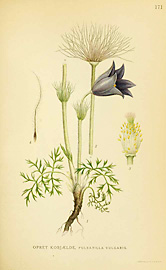Passed-Over Pasque Flower
By Audrey Stallsmith

“The wild anemony is called pasque-flower, from the paschal solemnity of our Savior’s death.”
Encyclopaedia Londinensis, Volume 18
Charmed by photos of the petite, ferny and fuzzy pasque flower, I’ve tried to grow it from seed several times. That’s not impossible, though the seed germinates sporadically and seedlings tend to damp off.
I finally managed to get one specimen past the seedling stage last summer. Once I’d planted it out, however, one of our animals promptly dug it up. Probably the dog, though it could have been a hen or guinea too. Fortunately, I was able to scrabble around in the dirt, find the poor wilted seedling, and replant it. Whether or not it will survive our winter from hell remains to be seen!
Pasch derives from the Hebrew for Passover. However, the pasque flower traditionally blooms on Good Friday, the day before Passover, with the flowers often appearing in advance of the leaves. In reality, it probably will perform late on years when Easter occurs in March. Its official name, Pulsatilla, derives from pulsc (“I beat”), indicating how it thrashes about in the spring winds.
Formerly called Anemone pulsatilla and now Pulsatilla vulgaris, the plant forms a rosette of finely divided and hairy leaves. Each stalk it sends up produces a single white, pink, purple, or red cup-shaped flower about 1 1/2 inches across, composed of 5 to 7 colored sepals rather than petals. Strangely enough, the purple sepals make a green dye—once used to tint Easter eggs.
Farther west in the U. S., the plant grows wild and is known as the prairie crocus. Also native to Europe, where it purportedly sprang up from the blood of Danish warriors killed in battle, it prefers to grow in gritty, alkaline soil in zones 5 to 9. According to whose superstition you believe, the plant can either carry disease or ward it off.
It once was used as a sedative and pain reliever and to treat many physical problems, including respiratory and eye conditions. However, a chemical it contains called anemonin has effects similar to the virulent poison in monkshood, and the plant could sedate you into a permanent “sleep.” So, in a way, both superstitions are right. The pasque flower can either heal you or kill you! Fortunately, it causes a burning sensation when eaten, so nobody tries to consume much of it.
Probably due to its short stature the plant stands for “you have no claims” and “unpretentious” in the Language of Flowers. Fairies supposedly like to bed down in its fluffy arms, however, and many of the rest of us still find this silver-haired greeter of spring magical.
Pulsatilla vulgaris image is from Bilder ur Nordens Flora, Vol. 1, courtesy of plantillustrations.org.








